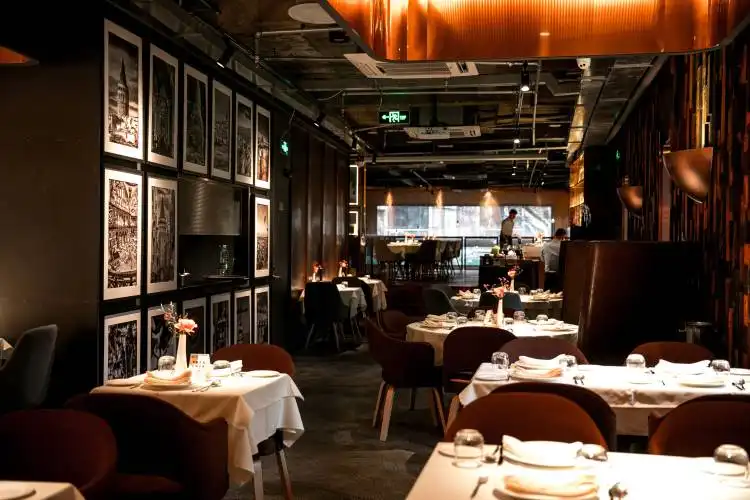Start a Fast Food Restaurant
Fast-Forwarding Hunger: The Speedy Charm of a Fast Food Venture
| Updated


FAST FOOD RESTAURANT
Embarking on a fast-food restaurant venture, are we? Imagine a place that serves delicious, finger-licking fries, burgers, shakes and more, all at lightning speed. This charming business model involves making quick service and convenience its top priorities, getting customers filled with delectable delight without the long wait. Think of it as the culinary equivalent of a pit stop where every meal service is a race against the clock! With a blend of foodie creativity and operational efficiency, your customers get to enjoy a tasty smackdown that literally ‘fast’ forwards their hunger pangs!
Jump to Business Plan
RELATED BUSINESS IDEAS
Browse ALL Food & Beverage Entrepreneurship Business Ideas
Discover Your Perfect Domain
Unlock the door to your online success with our hand-picked selection of premium domain names. Whether you're starting a new venture or rebranding an existing one, the right domain can set the tone for your digital presence. Browse through our curated list, each with its unique potential to enhance your brand's visibility and credibility.
FAST FOOD RESTAURANT MINI BUSINESS PLAN
This a quick reality check to help you identify the strengths and weaknesses of your business concept before you dive in.
Business Idea: Fast Food Restaurant
Expected Percent Margins:
- Gross Margin: 60-70%
- Net Profit Margin: 10-15%
Earnings Expectations:
- Daily Earnings: $1,500 - $3,000
- Weekly Earnings: $10,500 - $21,000
- Monthly Earnings: $45,000 - $90,000
- Annual Earnings: $540,000 - $1,080,000
Actions to Hit Those Numbers:
Inventory Management:
- Initial Investment: Minimum $100,000 - $500,000 depending upon location, size and brand.
- Effective Supply Chain: Solid relationships with vendors for fast, reliable delivery of ingredients.
Marketing and Customer Acquisition:
- Target Market Research: Understand who your customers are, targeted advertising can then be more precise.
- Community Engagement: Sponsor local events, offer student specials, engage with your community.
Sales and Customer Experience:
- Quick Service: The key to a successful fast food restaurant is speed. Ensure your staff is well-trained.
- Tasty and consistent food: Your customers should receive the same quality every time.
Cost Control:
- Rent: Keep your rent under 10% of your expected sales.
- Labor: Fast food restaurants are typically labor intensive, try to keep this under 30% of sales.
Business Operations:
- Long Hours: Be prepared for long hours, the fast food industry can be a 24/7 operation.
- Health and Safety: Ensure cleanliness, maintain highest standards of food safety.
Remember these numbers are estimates and actual numbers can depend on location, menu prices, and operating efficiency. Always consult with a business advisor for personalized advice.
NOT WHAT YOU HAD IN MIND? Here are more ideas



Browse ALL Food & Beverage Entrepreneurship Business Ideas
Grab Your Business Website Name
Before you get caught up in the whirlwind of setting up your business, invest in a domain name. It's a small but significant step that lays the foundation for your brand and makes it easier for customers to find and trust you. Just like you wouldn't build a house without securing the land first, don't build a business without securing your domain name.
"Why? Can't that wait?" Here's why it shouldn't
Step 1: Determine if Starting a Fast Food Restaurant is the Right Endeavor
Breakdown of Startup Expenses
When considering starting a fast food restaurant, it is important to understand the startup expenses that will be necessary. These expenses can include the cost of the building or space, the cost of equipment and furnishings, the cost of licenses and permits, the cost of insurance, the cost of staff, and the cost of advertising. It is important to research the costs of each of these items in order to get an accurate picture of the total startup costs.
Breakdown of Ongoing Expenses
In addition to the startup expenses, it is important to understand the ongoing expenses associated with running a fast food restaurant. These expenses can include the cost of food, the cost of utilities, the cost of staff, the cost of advertising, and the cost of maintenance and repairs. It is important to research the costs of each of these items in order to get an accurate picture of the total ongoing costs.
Examples of Ways to Make Money
Once the startup and ongoing expenses have been determined, it is important to understand the ways to make money in a fast food restaurant. Examples of ways to make money include offering discounts and promotions, offering catering services, offering delivery services, and offering loyalty programs. It is important to research the potential of each of these strategies in order to determine which ones will be the most profitable.
Step 2: Name the Business
When naming a fast food restaurant, it is important to keep the name simple and memorable. Consider using a play on words or a pun to make the name stand out. Additionally, it is important to make sure the name is not already in use by another business. Researching the name online and in the local area is a great way to ensure that the name is unique. Additionally, it is important to consider the target audience when selecting a name. For example, a name that appeals to children will be different than one that appeals to adults.
When selecting a name, it is also important to consider the potential for future growth. A name that can be adapted to a new location or menu item is ideal. Additionally, it is important to consider how the name will look on signage, menus, and other marketing materials. A name that is easy to read and remember is key. Finally, it is important to consider the potential for trademarking the name. Researching the name and registering it with the USPTO can help to protect the business from potential legal issues in the future.
Step 3: Develop a Business Plan
When developing a business plan, it is important to include a comprehensive outline of the components that will be included. This should include a mission statement, a description of the business, a market analysis, a financial plan, an organizational plan, and a marketing plan. The mission statement should be a short statement that outlines the purpose of the business. The description of the business should include the type of food that will be served, the location, and the target market. The market analysis should include an analysis of the competition, the current trends in the industry, and potential opportunities for growth. The financial plan should include a breakdown of startup expenses, ongoing expenses, and potential sources of revenue. The organizational plan should include the roles and responsibilities of the staff. The marketing plan should include strategies for attracting customers and promoting the business.
Research Potential Locations
When researching potential locations for the fast food restaurant, it is important to consider factors such as the local competition, the population of the area, the availability of parking, and the cost of rent. It is also important to research the local zoning regulations to ensure that the business is compliant with all local laws. Additionally, it is important to research the local demographics to ensure that the target market is in the area. It is also important to research the local infrastructure to ensure that the restaurant is easily accessible to customers. Finally, it is important to research the local labor market to ensure that there are enough qualified employees to staff the restaurant.
Step 4: Secure Financing
Securing financing is a crucial step in starting a fast food restaurant. There are several options available to entrepreneurs when it comes to financing their business. The most common options include taking out a loan from a bank, using personal savings, or seeking out investors. Taking out a loan from a bank is a popular option for entrepreneurs, as it allows them to borrow money without having to give up any equity in the business. Personal savings can also be used to finance the startup costs of a fast food restaurant, but this option is often limited by the amount of money available. Lastly, seeking out investors is another option for entrepreneurs who are looking for additional capital. Investors can provide the necessary funds to get the business off the ground, but they will also expect a return on their investment.
Obtaining Financing
Once the financing option has been determined, the next step is to obtain the necessary funds. For entrepreneurs who are taking out a loan from a bank, they will need to provide a detailed business plan and financial projections to demonstrate their ability to repay the loan. For those using personal savings, they will need to have the necessary funds available to cover the startup costs. Lastly, for those seeking out investors, they will need to create a compelling pitch to attract potential investors. It is important to note that obtaining financing can be a lengthy process, so it is important to start this step as early as possible.
Step 5: Choose a Location
When deciding on a location for a fast food restaurant, there are several factors to consider. First, the location should be easily accessible to customers. It should also be in an area with a high population density and have good visibility. Additionally, the location should have enough space to accommodate the restaurant’s needs, such as seating, kitchen equipment, and storage. Furthermore, the location should have adequate parking for customers.
Researching the Area
Once a potential location has been identified, it is important to research the area. This includes researching the local competition, the demographics of the area, and the local regulations. Additionally, research should be done to determine the average income of the area and the local consumer spending habits. This will help to ensure that the restaurant is successful in the area.
Negotiating a Lease
Once the area has been researched and a potential location identified, it is important to negotiate a lease with the landlord. This should include the length of the lease, the amount of rent, and any other terms that may be included. It is important to ensure that the lease is fair and that the terms are agreeable to both parties.
Securing Financing
In order to secure financing for the restaurant, it is important to have a business plan in place. This should include a breakdown of startup expenses, ongoing expenses, and potential sources of income. Additionally, it is important to have a detailed budget in place to ensure that the restaurant is able to cover all of its expenses. This will help to ensure that the restaurant is able to stay in business.
Step 6: Obtain Licenses and Permits
The types of licenses and permits needed to open a fast food restaurant will vary depending on the location and type of business. Generally, a business license, health permit, and food service permit are required. Depending on the state, additional permits may be required, such as a liquor license or a permit to serve alcohol. It's important to research the specific requirements for the area in which the restaurant will be located.
Obtaining Licenses and Permits
Once the types of licenses and permits needed are determined, the next step is to obtain them. This process can be time-consuming and complicated, so it's important to start early and be prepared to provide the necessary documentation. It's also a good idea to contact the local government to ensure that all the necessary paperwork is in order. Additionally, the business may need to be inspected before the licenses and permits are approved.
Cost of Licenses and Permits
The cost of licenses and permits will vary depending on the type of business and the location. Generally, the cost of a business license is relatively low, while the cost of a food service permit and health permit can be more expensive. Additionally, some states may require the business to pay an annual fee for the licenses and permits.
Keeping Licenses and Permits Up to Date
Once the licenses and permits are obtained, it's important to keep them up to date. This means renewing them when necessary and ensuring that any changes to the business are reported to the local government. Additionally, it's important to stay up to date on any changes to the laws and regulations that may affect the business.
Step 7: Purchase Equipment
When starting a fast food restaurant, there are certain pieces of equipment that are essential to the success of the business. These include a commercial refrigerator, a deep fryer, a grill, a stove, a food processor, a blender, a cash register, and a POS system. Additionally, depending on the type of food you plan to serve, you may need to purchase additional equipment such as a pizza oven, a waffle maker, or a sandwich press.
Where to Buy
When it comes to purchasing the necessary equipment for your fast food restaurant, there are a few different options. You can purchase the equipment from a local restaurant supply store, an online restaurant supply store, or even from a used restaurant equipment store. Additionally, you can also purchase the equipment from a manufacturer directly.
Cost
The cost of the equipment for your fast food restaurant will vary depending on the type of equipment you purchase and the quality of the equipment. Generally, the cost of the equipment can range from a few hundred dollars to several thousand dollars. Additionally, you may also need to purchase additional supplies such as utensils, plates, and cups.
Financing
If you do not have the funds to purchase the necessary equipment for your fast food restaurant, there are a few financing options available. You can apply for a business loan from a bank, look into government grants, or even apply for a business credit card. Additionally, you may be able to find a lender that specializes in financing restaurant equipment.
Step 8: Hire Employees
When it comes to hiring employees, it is important to find the right people for the job. It is important to look for people who are reliable, have a good work ethic, and have experience in the fast food industry. It is also important to make sure that the employees have the necessary skills to handle customer service, food preparation, and other tasks that may be required. Additionally, it is important to make sure that the employees are aware of the company’s policies and procedures. It is also important to provide training to the employees so that they are up-to-date on the latest industry trends and regulations.
Benefits of Hiring Employees
Hiring employees can be beneficial for a fast food restaurant. Employees can help to ensure that the restaurant runs smoothly and efficiently. Additionally, having employees can help to reduce the amount of time that the owner or manager needs to spend on tasks such as food preparation, customer service, and other tasks. Additionally, having employees can help to increase customer satisfaction as they can provide better customer service and faster service. Finally, having employees can help to increase the restaurant’s profits as they can help to increase sales and reduce costs.
Step 9: Market the Business
The best way to market a fast food restaurant is to create a strong online presence. This can be done by creating a website and social media accounts that are regularly updated with information about the restaurant. Additionally, it is important to create a loyalty program to reward customers who visit the restaurant frequently. This will help to create a sense of loyalty and encourage customers to return. Additionally, it is important to create promotional materials such as flyers and posters that can be distributed in the local area. Finally, creating partnerships with local businesses can be a great way to get the word out about the restaurant and attract new customers.
Tips for Marketing a Fast Food Restaurant
When marketing a fast food restaurant, it is important to focus on the unique aspects of the restaurant. This could include the type of cuisine, the atmosphere, and the customer service. Additionally, it is important to focus on the quality of the food. This can be done by creating a menu that is both appealing and affordable. Additionally, it is important to create a strong brand identity that will help customers to recognize the restaurant. Finally, it is important to use targeted advertising to reach the right customers. This could include using online ads, radio ads, or television ads.
EXPLORE MORE CATEGORIES
Browse ALL Business Idea Categories
TAKE THE NEXT STEPS










